NVIDIA's GeForce GTX 465: Cheaper Isn’t Always Better
by Ryan Smith on May 31, 2010 3:26 AM ESTPower, Temperature, & Noise
In our GTX 480 review, we identified both the GTX 480 and GTX 470 as being abnormally hot & loud. Perhaps with the reduction in functional units and a lower memory clock speed NVIDIA will be able to bring this in to check? Let’s find out.
Or not.
Let’s first start with core voltage. For the GTX 400 series NVIDIA does not use a single voltage for each card, instead they assign voltage on a per-chip basis. So while there are trends we can look at, there is no absolute single voltage as we’ve seen on past cards. The following is the load voltage on each of our sample cards.
| GeForce GTX 400 Series Load Voltage | |||
| GTX 480 | GTX 470 | GTX 465 | |
| Load Voltage |
0.959v
|
0.962v | 1.025v |
In terms of core voltage the GTX 465 ends up being a notable outlier. Our GTX 480 and 470 samples have a load core voltage of 0.959v and 0.962v respectively according to GPU-Z, while our GTX 465 from Zotec is a good 0.04v higher at 1.025v. This is only a 4% increase in core voltage overall, but as GF100 has an idle voltage of .875v, this means it takes a 50% greater voltage increase over idle to bring our GTX 465 to load compared to our GTX 470.
NVIDIA is dealing with some very tight thermal and power requirements on the GTX 480 and 470 – getting a 3 billion transistor chip to not run amok drawing power is hard work. From this we can infer that NVIDIA is not only holding back chips with damaged functional units, but also chips that run but just take too much voltage (and ultimately power) to do so. With fewer functional units, the GTX 465 has a greater tolerance for high-voltage chips and it looks like this is where NVIDIA is sending some of them as a result. This is why there’s only a 15W TDP difference between the two cards: NVIDIA “spent” their savings getting lesser GF100 GPUs in to products. So going by voltage alone, it’s clear that we’re not going to see the GTX 465 receive a huge benefit in terms of power, temperature, & noise.
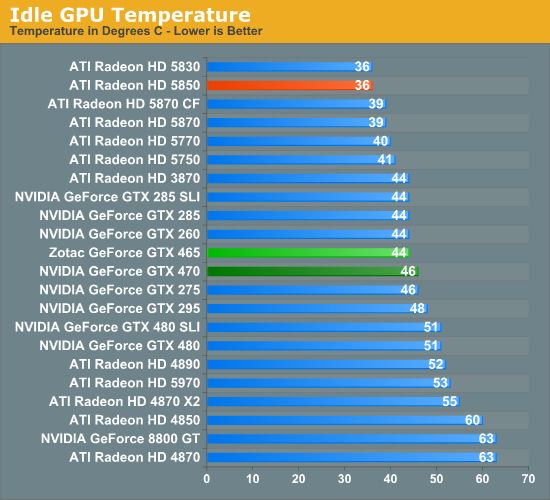
Moving on to our charts, we’ll start with idle temperatures. Even with the same idle voltage and same cooler as the GTX 470, the GTX 465 delivers a slight surprise: it ends up idling at 2C under the GTX 470. This puts it squarely in the same territory as the GTX 200 series.
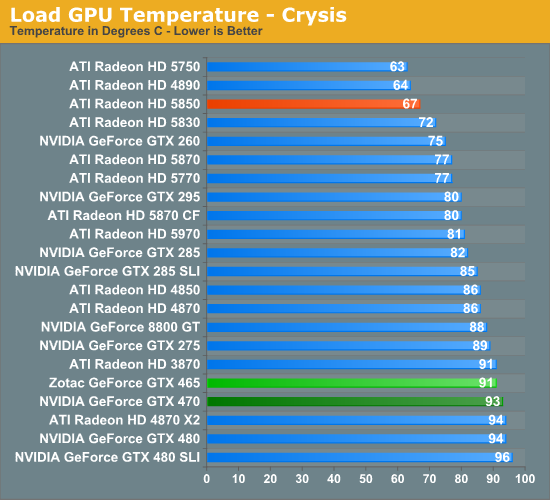
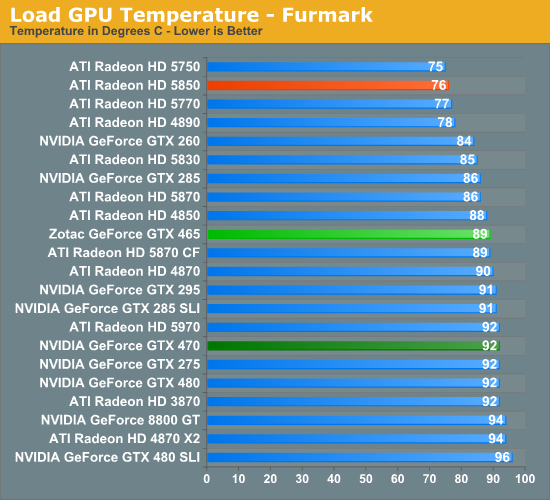
Moving on to load temperatures, we can begin to see the price of using a GPU with a higher core voltage. Under Crysis that 2C advantage over the GTX 470 holds, with temperatures peaking at just 91C. This still makes it the 3rd hottest single-GPU card we have tested, tieing with the Radeon HD 3870 and coming in 24C hotter than the 5850, a card it underperforms in this game.
FurMark has a similar showing, with the GTX 465 coming in 3C cooler than the GTX 470. Overall things are better for the GTX 465 here though, as it’s better than roughly half of our cards here, placing amongst the Radeon HD 4890, 4850, and only a hair above the 5870 and GTX 285. Even the gap between the GTX 465 and 5850 drops quite a bit, with only 13C separating the two.

Next we have idle power consumption, measuring the total power consumption of our GPU testbench. While NVIDIA didn’t give the GTX 465 an official idle power draw, we’re measuring it at 1W less than the GTX 470. The GTX 470 was rated for 33W, so it’s safe to say the GTX 465 is close to that. It’s quite likely that the difference comes down to the savings from running 2 fewer GDDR5 RAM chips.
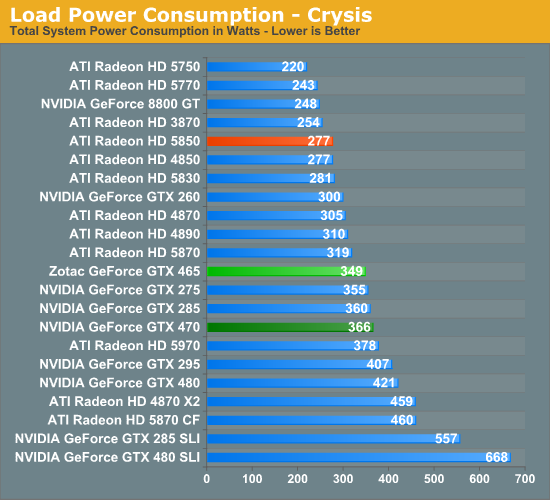
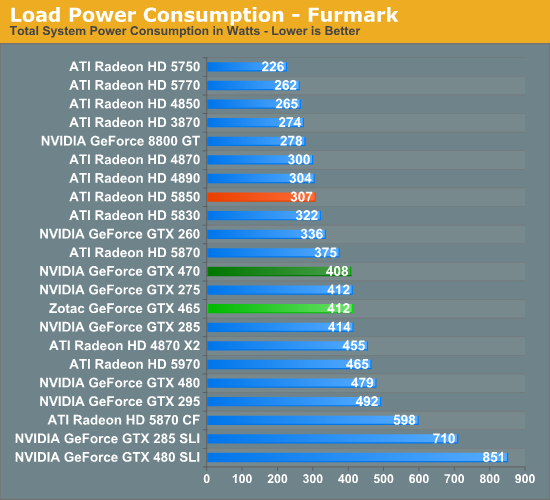
As for load power draw, having seen our temperature results the actual power figures should not be a surprise. Under Crysis the GTX 465 has more in common with the GTX 470 than the power-saving Radeon HD 5000 series, drawing 17W less than the GTX 470 and 72W more than the 5850. Based on our voltage numbers from earlier and this data, it’s clear that NVIDIA had to give up a lot of power savings to make this specific GPU operate.
Meanwhile under FurMark we see those savings evaporate in to nothingness. Here the GTX 465 actually surpasses the GTX 470 by 4W, coming in at 412W versus 408W. At this point it’s drawing as much power as a GTX 275/285, and 105W more than the Radeon 5850. We did not expect the GTX 465 to end up drawing more power than the GTX 470 here, as the 2 fewer RAM chips should have offset the difference. Looking at just the GPU, there’s a good chance the GPU in our GTX 465 card is drawing more power than the GTX 470 under most situations.
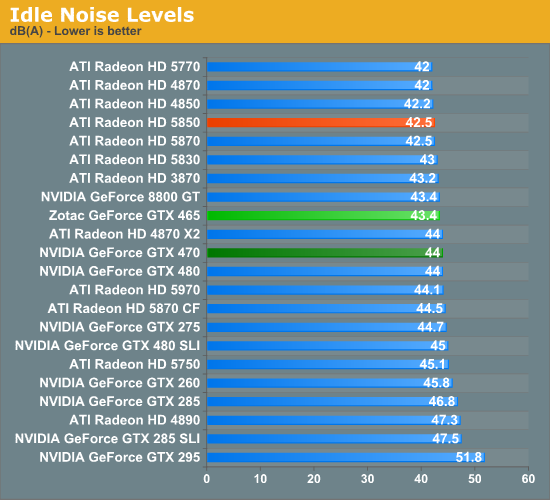
Last but not least we have our noise testing. As the GTX 465 uses the same cooler as the GTX 470, the results should be very close and our idle noise measurements deliver on that. Our GTX 465 idles at 43.4db(A), effectively tied with the GTX 470 and only marginally different than most of the rest of our cards.
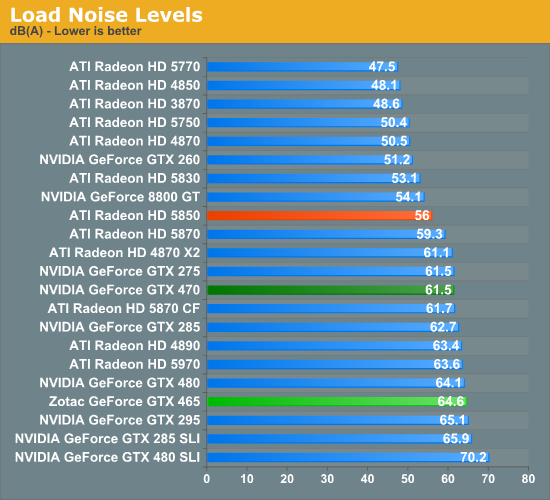
When we first did our load noise testing on our GTX 465, we thought something was wrong. It sounded louder than the GTX 480 or GTX 470, and when we put a sound meter to it the results reflected that. But after triple-checking our results there’s nothing wrong with our data – the GTX 465 really is louder than the GTX 470 and the GTX 480. As fan speeds are tied to the GPU temperature we’re looking at the culprit being the fan profile used for the GTX 465, as the hardware is identical to the GTX 470. It looks like NVIDIA tweaked the GTX 465 to be a bit more aggressive than the GTX 470, which in turn makes this the likely reason why we’ve measured the GTX 465 as being cooler than the GTX 470 in spite of their similar power draw.
Our best guess here is that with the GTX 465’s higher operating voltage, NVIDIA wanted a slightly lower operating temperature to compensate. As with any other case where we’ve only measured a single card there’s the possibility of a great deal of variation, but what we’ve seen makes sense. Across the entire spectrum of GTX 465 and GTX 470 cards it’s reasonable to assume this data is correct and that the GTX 465 is on average a couple of db(A) louder than the GTX 470.
It goes without saying that this isn’t a reasonable amount of noise for the performance the card delivers. The Radeon HD 5870 is 5dB(A) quieter, and the 5850 extends than to 8dB(A) quieter. At these noise levels 8dB(A) is a very noticeable difference.










71 Comments
View All Comments
iantis - Monday, May 31, 2010 - link
Honestly, I feel like the more important measure is greenhouse gas emissions, anyway. Power is so cheap in America. I suppose if you play computer 20 hours per day it will hit your wallet, but the carbon emissions are what really matter imho.Zoomer - Wednesday, June 2, 2010 - link
Think it's getting off topic now. Others may not agree.oldscotch - Monday, May 31, 2010 - link
I thought it'd be a good year or two before we'd start seeing gpu reviews with the phrase "only 1gb of ram".aegisofrime - Monday, May 31, 2010 - link
"NVIDIA pegs the GTX 470 at 200W TDP, 15W below the GTX 470’s official TDP"I believe the first 470 in the sentence should be 465 instead?
Exodite - Monday, May 31, 2010 - link
The GeForce GTX465 comes off as an even worse deal than the Radeon 5830, no mean feat to be sure.It'll be interesting to see how the GTX460 holds up under scrutiny once it arrives, being based on another chip should help a lot with the worse metrics of thee 400-series I hope. Meaning power, heat and noise that is.
gtr92 - Monday, May 31, 2010 - link
I think there's a typo on the L4D page."The GTX 465 ends up losing to the GTX 285 here, and even the GTX 475. Compared to the GTX 285 the GTX 465 is..."
The 2nd and 3rd sentence in the last paragraph, I think it's supposed to be GTX 275, not 475.
xxtypersxx - Monday, May 31, 2010 - link
I have had my GTX 280 for 2 years now and it is pretty surprising to see how close its die shrunk brother the GTX 285 is to the GTX 465 and Radeon 5850 in benchmarks. I will likely not upgrade for another year while I wait for meaningful advancements and that gives this card a usable lifespan rivaling the fabled 8800gtx!On another note, after reading this and my recent experience with a GT240 I have definitiely learned to look beyond SP count. For a while the number of shader processors (within a brand anyway) was a pretty dependable way to gauge relative performance. Now with Nvidia and ATI hacking away other critical components in their salvaged dies we see this really fall apart (GTX 285 vs GTX 465 and Radeon 5830 vs Radeon 4890).
JAG87 - Monday, May 31, 2010 - link
after I read the BC2 charts, I just moved on to a different review. if you don't have time to re-run the benchmarks then don't include skewed numbers in your charts, just for the sake of completion. we understand that you don't have a week to dedicate for every product review, but don't make these silly mistakes.fausto412 - Monday, May 31, 2010 - link
i'm sorry but nvidia must think we are idiots. trying to sell us these super power hungry, super hot, not 100% cards and not competing head on with AMD? what game of chicken shit is this?i'm waiting for them to get real and for prices to come down. at this pace ATI will have something faster than 5870 for me to buy that will run cooler and be positioned to make the gtx480 look like a freaking toy.
osideplayer - Monday, May 31, 2010 - link
I really don't know what's up with Nvidia right now, but I hope they don't go downhill. It seems with like they are really falling apart with intel and now they are loosing at their own game :( I have a Nvidia 260, an I7 920 and 6GB DDR3 ram they have worked together flawlessly. I'm glad you guys are still putting up benchmarks for them. I love this site.